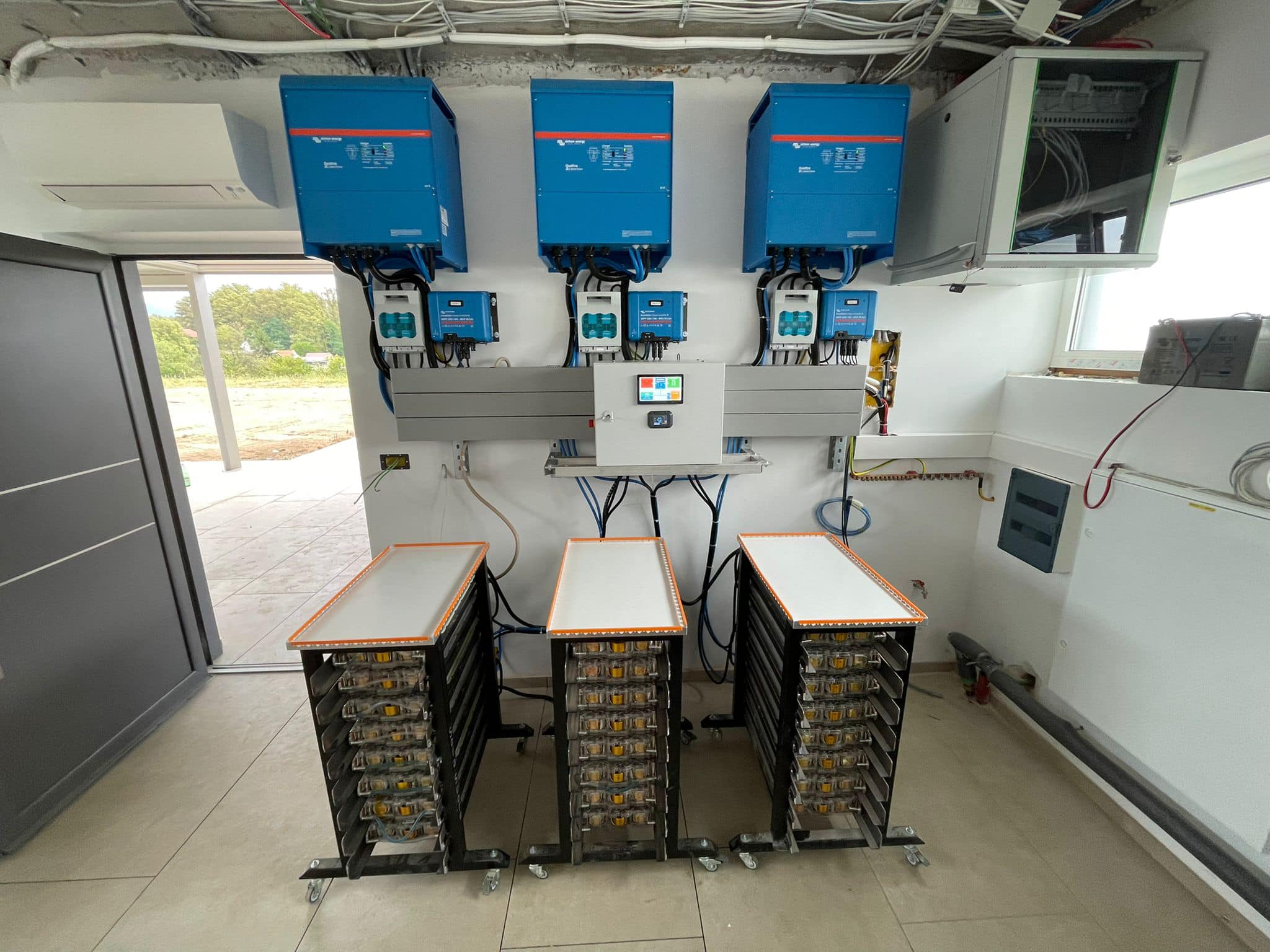
Tesla saves and conserves your money even when it completes its cycle on the road by continuing its new cycle in a stationary solar system. A battery that is no longer suitable for a vehicle is still fully functional for other “second life” applications. In this example, we refurbished defective Tesla modules from a 2012 Tesla S85 that had an average of around 300,000 km on the road and repurposed them as a battery UPS system for solar inverters, creating a fully autonomous energy system for a household where the city grid serves only as a backup generator. The cycle of a battery in a vehicle endures far greater stresses, electrical loads, vibrations, thermal expansions, moisture, and more. None of these conditions exist in a stationary system, making the conditions for automotive batteries in a stationary system completely relaxed. In a stationary setup, the batteries are connected in parallel at a lower voltage, and all current loads are up to 100 times lower than in a vehicle. The larger the system, the longer the projected lifespan of the battery. The biggest mistake in designing such systems is integrating a small battery where it is exposed to high currents and rapid charging/discharging cycles. Automotive batteries are at least twice as good as any commercially available ones because they are made with far superior materials, processes, and quality checks.
Our SOLAR Tesla project includes a 3D printed CROBMS and custom LCD housing by T.S. Custom. The solar panel installation was carried out by Ivan Perić, and the inverters and MPPT are by Victron Energy B.V. After six months of planning, designing, and organizing parts, the project is finally complete. Though it still requires some fine-tuning, it has successfully passed thermal and functional testing at 900 amps over two days.
The system comprises:
- 3x MPPT 250/100
- 10kWp + 3x 13KW Victron Quattro (15000VA) hybrid UPS
- Recycled defective and used 32 pieces of 24V 200Ah Tesla Model S blocks, providing a total net capacity of 147kWh (usable range) and a gross capacity of 170kWh.
- The battery system is controlled by the CROBMS EV Clinic (Made in Croatia) master system in a box, functioning as a LowVoltage JunctionBox. This includes DVCC, balancing, temperature control, 1200A contactors, overload protection, over-temperature protection, low-temperature protection, cell imbalance protection, undervoltage protection, short circuit protection, and 20 more security features.
The system features 56 temperature sensors and 21,312 fuses on the cells, along with an additional 15 heavy-duty fuses on the busbars.

In addition to the Victron 36kW “baseload” system, there are on-grid LG panels connected to AC OUT1, providing 10kWp and a 10kW 3-phase SolarEdge system. This system primarily shares the load with the house consumers, with any surplus energy being stored in the Victron batteries (no energy is returned to the grid).
The third additional power source (aka generator) is the grid itself, which boosts the system from the controlled 18kW power(with overload protection and limiter) through the Victron transformer, combining grid power and battery power. This boosts the basic load from the grid-limited 18kW to 54kW, resulting in a total peak system power of 64kW. The system is galvanically isolated from the grid, ensuring that no energy is fed back into the network. Surplus solar energy is consumed by a Bitcoin miner (with BTC network purchase over €0.13 per kWh).
The expected lifespan of the battery is an additional 6-10 years. The operating conditions for the repaired batteries are much milder than those in a working vehicle—there are no vibrations, moisture, or thermal expansion due to varying temperatures, and the amperage is lower. The 14kW resistance of the AC system is 340A on the battery, equivalent to the power of about 9.9kW in a vehicle. This means that even under heavy household consumption, the batteries work under conditions twice as easy as in a vehicle. There is no DC ripple or violent amperages like in a vehicle, which can reach up to 800A. To simulate vehicle conditions (acceleration up to 100 km/h), this system would need to load with 9600A in these 2s12p configurations (12s912p 18650).
The system avoided the need to extend the grid connection from 18kW to 30kW, as the request was rejected by the government, where They asked for €27,000 for the extension of the transformer station. It also avoided the red tariff of €0.33 per kWh, the lease of excellent power, and the payment of electricity connection fees of €200 per kW.
The full investment repayment is expected in 18-30 months, with the current average consumption of 3000kWh per month and current kWh prices. The cost of the system provides energy independence and cheap energy, which is priceless.
System Specifications:
64kW three-phase power
22kW of solar panels
150kWh net Tesla battery
This example demonstrates that the end of life for an electric vehicle is not mandatory. Every part of an EV can be reused. Even degraded batteries can be effective for storage systems when they are no longer suitable for EVs and mobility.

























